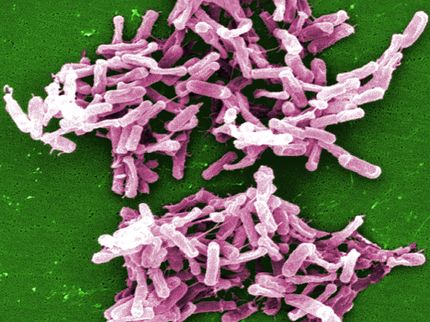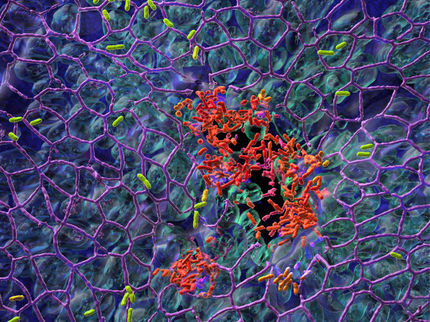Natural plant toxin as a new broad-spectrum antibiotic
Modifying the sugarcane leaf blight disease trigger - albicidin - so that it is effective against multidrug-resistant hospital pathogens
Advertisement
In cooperation with scientists from the UK and Poland, the research group led by Prof. Dr. Roderich Süssmuth from the Department of Organic and Biological Chemistry at TU Berlin was able to use electron microscopy at low temperatures to capture snapshots of how albicidin inhibits a vital enzyme in bacteria. By knowing this mechanism of action in detail, they were then able to use computer simulations and chemical synthesis in the lab to create variants of the original albicidin molecule that are effective against some of the most dangerous bacterial infections in hospitals. The results have now been published in the journal Nature Catalysis.

João Lima / Pixabay
Multidrug-resistant pathogens such as Escherichia coli, Pseudomonas aeruginosa and Salmonella typhimurium pose a dangerous burden to healthcare systems, one that is exacerbated by the COVID-19 pandemic. Infections with resistant pathogens are a leading cause of death in intensive care units, with some strains becoming pan-resistant, meaning that all current antibiotics no longer work. Over 35,000 people die each year in Europe due to antibiotic resistance, according to estimates by the EU health agency ECDC [1]. The urgent search is therefore on for new antibiotics that are effective against many bacteria and do not develop resistance so quickly.
Albicidin, a plant toxin, offers new hope
A new source of hope is the natural plant toxin albicidin. Back in 2015, Roderich Süssmuth's research group, together with French scientists, was able to elucidate its chemical structure. Albicidin is produced by the bacterium Xanthomonas albilineans, which causes the devastating leaf blight disease of sugar cane. The pathogen uses albicidin to attack the plant, use it as a host organism and spread further.
In recent years, researchers have understood how this bacterial strategy works: it targets an enzyme called DNA gyrase (or simply "gyrase"). This enzyme attaches to DNA and unwinds it. This becomes important whenever the cell wants to divide, and to do so, the DNA must be copied completely. However, gyrase has an Achilles' heel: In order to perform its task, it has to cut the DNA double helix completely for a short time. This is a dangerous moment for the cell, because there is a risk that the DNA ends will not rejoin correctly. Normally, gyrase quickly rejoins the two pieces of DNA, but albicidin prevents this, resulting in damaged DNA and the death of the cell.
Deadly also for bacteria
In this way, albicidin can not only help the sugarcane pest in its work of destruction. This is because the gyrase enzyme it attacks is not found exclusively in plant cells, but also in bacteria. In humans, on the other hand, although there are related enzymes, the differences from gyrase are sufficiently great that albicidin is highly unlikely to harm us. Importantly, the way albicidin interacts with gyrase is also sufficiently different from existing antibiotics that, after chemical optimization, albicidin is likely to be effective against most of the current antibiotic-resistant bacteria known as "superbugs." This makes the compound a prime candidate for the eagerly awaited new broad-spectrum antibiotic.
Elucidating the mechanism of action with cryo-electron microscopy.
"Despite its known antibiotic potential and low toxicity in preclinical experiments, it is necessary to optimize the structure and composition of the albicidin molecule, which is nevertheless quite large, for its use as a drug," explains Roderich Süssmuth. "In chemistry, we speak here of a 'rational design' of the molecule. But this has so far been hampered by the fact that we didn't know exactly how albicidin interacts with gyrase."
That's why the research group at TU Berlin teamed up with the lab teams of Dr. Dmitry Ghilarov at the John Innes Centre in Norwich, UK, and Prof. Jonathan Heddle at Jagiellonian University in Krakow, Poland. With their help, albicidin could be virtually observed at work. They used a technique known as cryo-electron microscopy. Electron beams are used at low temperatures below minus 150 degrees Celsius to record the processes at the molecular level without blurring in thousands of snapshots. The result: albicidin forms a kind of L-shape and can thus interact in a unique way with both gyrase and DNA. In this state, the gyrase can no longer move to bring the DNA ends together. Albicidin's action here is similar to a wrench thrown between two running gears, blocking them.
Bacteria won't build resistance as quickly
"It seems that because of the nature of the interaction, albicidin targets a really essential part of the enzyme, and it would be difficult for bacteria to develop resistance to it," says Roderich Süssmuth. Kay Hommernick, the doctoral student involved in the work, adds, "Now that we have a structural understanding, we can increase the number of binding sites between albicidin and the gyrase and make further modifications to the molecule to improve its efficacy and pharmacological properties." Using computer visualizations, the team has already chemically synthesized variations of the antibiotic with improved properties. In tests, these variants proved effective against some of the most dangerous bacterial infections in hospitals, including Escherichia coli, Klebsiella pneumoniae, Pseudomonas aeruginosa and Salmonella typhimurium. Albicidin was highly effective at even small concentrations.
Search for sponsors for clinical trials
The next step for this research is to collaborate with other academic and industrial partners* and seek funding to advance the research to human clinical trials, Süssmuth explains. "If these are successful, albicidin would establish a whole new class of antibiotics - and could save the lives of many thousands of people every year."
Note: This article has been translated using a computer system without human intervention. LUMITOS offers these automatic translations to present a wider range of current news. Since this article has been translated with automatic translation, it is possible that it contains errors in vocabulary, syntax or grammar. The original article in German can be found here.
























































